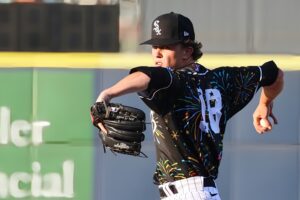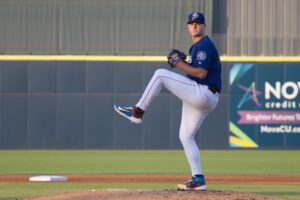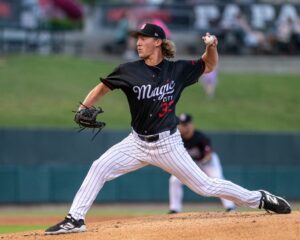Top White Sox Prospects ranked 16-30, Pre-season 2019
Twice annually, the writers at FutureSox work together to produce a list of the top prospects in the White Sox system. We use a voting system among the staff, then argue out specific players and rankings until we come to a final list. The list is then released in two parts.
This is the “teaser,” where we release the back half of the list with player capsules for prospects ranked 16-30. The full list of top 30 prospects, with a more detailed overview, capsules for 1-15, and a list of players who just missed the Top 30, will be released the next day.
ELIGIBILITY: We consider a “prospect” any player in the White Sox organization who has not yet achieved MLB Rookie status.
HOW WE EVALUATE PROSPECTS: You can read this primer to get an idea of how we go about the sticky, subjective business of ranking prospects. Our contributors took in a total of 60+ games in person this year at the affiliates as well as Spring Training.
STATE OF THE SYSTEM: The full list article will go into more detail on this, but here are a few key things to know. There were very few prospects who “graduated” or otherwise left the system, but also not many additions since our last list in July/August of 2018. The White Sox system remains one of the deepest in baseball.
FOR MORE DETAILS: If you click on the bolded player’s name, you’ll be taken to that player’s prospect profile, where you can find deeper details, links to videos and other content.
THE LIST (prospects ranked 16-30)
16. Seby Zavala, C [Previous: 17th, +1]

- Drafted 12th Round in 2015
Seby Zavala has been hovering around the teens on our list for a couple years now, straddling some conflicting views among our own writers. On the offensive side, Seby shows above average power and enough bat control and plate discipline for his walk and strikeout rates to be decent and usually hit for average. His showing at the plate in AAA in 2018 was lackluster statistically (.242/.266/.347 in 48 games), but some of that could be due to a barking wrist he wrestled with during the campaign. Defensively he’s got an average arm, gets plaudits for his work with pitchers and athletic defensive movements when out of the crouch, but has struggled with blocking pitches. That last category has seen improvement in the last year though, which helped propel him to Charlotte ahead of Zack Collins due to defensive readiness. Added to the 40-man roster in November, look for this backstop to make his MLB debut in 2019.
17. Ian Hamilton, RHP [Previous: 19th, +2]

- Drafted 11th Round in 2016
Hamilton‘s stock took a big jump in late 2017. Some mechanical changes resulted in a big increase in his fastball velocity, putting it into the upper 90’s and touching as high as 99, and his upper 80’s slider started showing more sharpness. No surprise then that the right-hander made a big run through the system in 2018 from AA to AAA to his MLB debut late in the year. Don’t read too much into his results in just eight innings in the bigs, especially given the quick run-up. Hamilton possesses a heater-slider combo that should make him an effective major league reliever and potentially could find a high leverage role as the Sox reach their competitive window. Command will dictate how far he can go.
18. Gavin Sheets, 1B [Previous: 18th, unchanged]

- Drafted 2nd Round in 2017
It isn’t often a prospect does everything you want to see and more, with a single glaring exception. Gavin Sheets hit .293, drew walks at a 10.5% rate, and drew positive marks for his defensive work at first base. What he didn’t do was translate his plus raw power into over-the-wall game results, hitting just 6 home runs despite playing his home games in a power-friendly park. Gavin has been asked about this multiple times, including by us and by The Athletic, and he’s certainly aware this is a necessity going forward. If he can maintain the other successes while getting the power numbers up to expectations, he will rise on the next list. Until then he’s on the fence.
19. Jordan Stephens, RHP [Previous: 16th, -3]

- Drafted 5th Round in 2015
Like fellow 2015 draftee Zavala, Jordan Stephens has been hanging around the teens on our lists basically since the rebuild began. A TJS survivor (in college), this Texan has a shorter than typical pitcher’s frame but he’s very athletic. His repertoire has morphed over the years, currently featuring a 4-seamer that typically runs 92-95 that he works high, a curve that is his best breaking pitch, change-up, 2-seamer and a slider/cutter that has had different iterations (and no one seems clear which it actually is). The results in his first AAA look in 2018 were just OK (4.71 ERA, 9.6 H/9, 3.5 BB/9, 8.3 K/9) in 21 starts. Added to the 40-man this off-season, assuming Stephens shows well returning to Charlotte, look for him to get to Chicago sometime this season either as a starter or a long reliever, though the 4S-cutter-curve combo could play in the pen.
20. Tyler Johnson, RHP [Previous: 23rd, +3]

- Drafted 5th Round in 2017
Flame-throwing right-hander Tyler Johnson has moved steadily up the rankings since his pro debut. Early struggles with an arm-heavy and inconsistent delivery have diminished substantially. In current version, Johnson’s fastball sits 94-98 and has touched 100, garnering grades of 60 or even higher from scouts and analysts for the velocity and movement. His go-to secondary pitch is a slider in the low-to-mid 80’s that shows substantial bite and command is improving. He also throws a change-up in a similar velocity band with the slide piece. The numbers in 2018 were gaudy: 1.40 ERA, 0.88 WHIP, 5.4 H/9, 2.5 BB/9, 13.8 K/9. Johnson has a chance to be a high-leverage reliever in the big leagues and a darn good one if his trajectory stays true.
21. Bryce Bush, 3B [Previous: Unranked]

- Drafted 33rd Round in 2018
The biggest leap on our list comes from a 33rd round pick, but don’t let that fool you – the $290,000 bonus Bryce Bush signed for is more in line with a high 6th round selection. After a surprise signing (at least to outsiders), the Michigan prep product went to the AZL and hit a ridiculous .442/.538/.605 in 14 games before being promoted to Great Falls. There his numbers weren’t as impressive but he still showed well against older competition (.250/.327/.385 while 2-3 years younger than league average). In-person reports spoke of impressive athleticism and surprisingly advanced bat control and zone judgment for his age. Defensively it’s another story and we don’t know if third base is truly his future home, but the physical tools make the outfield a possibility. There are lots of questions but also lots to dream on here, with Bryce entering his age 19 season. You can read more about his unusual draft and signing story here.
22. Jimmy Lambert, RHP [Previous: 26th, +4]

- Drafted 5th Round in 2016
After two middling pro seasons, Lambert combined some delivery changes with added muscle to provide big improvement in his stuff. His fastball went from 90-92 to more 92-94, touching higher than that, and he’s found better tunnels for it too. The arsenal also includes a curveball that is probably his best off-speed offering, along with a slider and change-up, the latter of which has improved in effectiveness due to better gapping against the fastball. In 2018 he was promoted to AA Birmingham mid-season and threw five very nice starts (2.88 ERA, 2.2 BB/9, 10.8 K/9). Durability had been a hallmark for Lambert in college and early as a pro, but he did get shut down a little early in 2018 due to an oblique strain this probably not a long-term concern.
23. Bernardo Flores, LHP [Previous: 28th, +5]

- Drafted 7th Round in 2016
Another pitcher taken in the 2016 draft, Bernardo Flores has also been marching up the list over the last year. The lefty’s track record and stuff had been erratic in his first 1.5 years as a pro – the velocity band on his four-seam fastball alone was around 8 mph in 2017, which his pitching coach at the time said drove him “nuts”. In 2018 we saw noticeable improvement, and you can read this report to get the side-by-side read, though further improvement happened after that. Split between A+ and AA as a 22-year-old last year his numbers came in at: 2.65 ERA, 1.8 BB/9, 6.1 K/9. Flores locates his pitches quite well from what is now a smooth, repeatable delivery. He throws a low-90’s fastball that has some sink, a big bender in the 70’s, a change-up with good action and a lesser-used slider.
24. Konnor Pilkington, LHP [Previous: 21st, -3]

- Drafted 3rd Round in 2018
The team’s 3rd round pick last June only saw brief action in his pro debut, throwing just 14 innings across the two rookie affiliates, so our evaluation rests heavily on draft-time write-ups. After his sophomore season with Mississippi State, Konnor Pilkington was discussed as a potential upper half of first round pick for the following spring, but in his junior season the bottom dropped out of his velocity (from mid-90’s to 88-91) and concerns allowed him to drop in the draft. According to MLB Pipeline at draft time, Konnor also had a 55-grade change-up that might be his best pitch, along with a slider that is projected to at least average, all thrown at a noticeable downhill plane from a high release point. 2019 will tell us a lot more about this left-hander.
25. Laz Rivera, SS [Previous: Unranked]

- Drafted 28th Round in 2017
The second player making his debut on our lists, Laz Rivera has already surpassed any reasonable expectations from a 28th rounder. The first hints that the White Sox may have found a diamond in the rough came in his pro debut and in Fall Instructs right after, where multiple reports emerged of a very quick bat and excellent defensive instincts at shortstop. In his first full pro season, the results began to echo the reports: .314/.361/.481 with 13 HR, 30 2B and 10 steals across both levels of A-ball while impressing coaches and analysts defensively. Aside from being 23 years old in A-ball, the other main concern was his allergic reaction to walks – he drew just 13 in 514 PA. But in his AFL stint he showed signs of working longer counts, which is encouraging. The Sox seem determined to move Laz quickly and he should see AA in 2019, if not right away then during the season.
26. Lenyn Sosa, SS [Previous: 23rd, -3]
- Signed from Venezuela in 2016
Sosa grabbed people’s attention by hitting .270 with strong contact and walk rates in the AZL in 2017, despite being just 17 years old. In 2018 in Great Falls at 18, his offensive totals only improved: .293/.317/.406, just 36 K in 291 PA (though the walks fell back some). Local reports from the PIO were limited, but his athleticism stood out on the team and he seems to have a good shot to stick at shortstop. Reports from Ben Badler of Baseball America at signing time in 2016 stated that some saw Sosa as one of the best hitters in his signing class, and also lauded his hand-eye coordination as standing out. There are more questions than answers on Sosa at this point, but he could see full season ball in 2019 and we’ll get a much better idea at that time.
27. Luis Curbelo, SS/3B [Previous: 27th, Unchanged]

- Drafted 6th Round in 2016
There is more data to work with on Luis Curbelo than there is on Sosa, but that doesn’t make evaluation any easier in this case. The results just haven’t shown up yet as a pro at the plate. He slashed .226/.303/.323 in rookie ball in 2016, missed virtually all of 2017 to injury, then put up a similarly worrying .237/.282/.337 line in Kannapolis this past season. Context is key – he hit full season ball at age 20 with just those 45 rookie league games under his belt and had missed a year of development. The tools keep him on the radar: the 104th-ranked prospect at draft time has big time bat speed, projects to above average power according to evaluators, and has plenty of arm strength for any infield slot and soft hands. Likely a third baseman going forward on range concerns, Curbelo needs the tools to start translating to results in 2019 to stay on these lists, and he likely repeats at Kannapolis for his age 21 season.
28. Jonathan Stiever, RHP [Previous: Unranked]

- Drafted 5th Round in 2018
Our third and final newbie on the list, the team’s 5th round pick in June was given 3rd round grades by multiple publications prior to the draft. Jonathan Stiever‘s arsenal is led by a fastball with run and sink in the low-to-mid 90’s that gets 60 grades. He also gets above average grades on his spike curve, and throws a change-up as well. The Indiana product got in 13 abbreviated starts (28 IP) with Great Falls in his pro debut, showing strong peripherals (2.9 BB/9, 12.5 K/9) and gaining multiple positive reports from local observers. Having just turned 21 at draft time he was on the young side for a college draftee, putting him in line with league average for the PIO. Stiever should be in Kannapolis’ rotation to open 2019.
29. Kodi Medeiros, LHP [Previous: 22nd, -7]

- Drafted 1st Round (12th overall) in 2014 by MIL, acquired via trade July 2018
Medeiros comes with a strong draft pedigree, but currently there is some question whether he can remain a starter or will be more valuable out of the bullpen. He’s got a low 90’s fastball that reach 95 and gets above average grades, paired with a slider that MLB Pipeline calls “plus with big lateral break”, and a change-up that has also garnered positive reviews. What he’s lacked is command and control – he walked 5.8/9 in his short stint with AA Birmingham to end last year. That combined with his sweeping arm slot make him a potentially lethal LOOGY candidate if he can improve his location. On the 40-man roster, should Medeiros improve in that regard in 2019, he could end up in Chicago before the year is out.
30. Spencer Adams, RHP [Previous: 20th, -10]

- Drafted 2nd Round in 2014
No one on this list has spent more time among our Top 30 (every list since he was drafted), nor seen such ups and downs on it (ranked 3rd to 30th), as Spencer Adams. He’s been through so many changes it’s probably best to just go with what we see today (read his profile if you want the history). Adams has a pretty ideal pitcher’s frame and a clean, north-south delivery. His primary fastball will run 91-94 and has touched as high as 96, and he mixes in a two-seamer, slider and change-up. With occasional exception he’s excelled at locating all of them, but he lacks a true out pitch. Neither the heater nor the slider have shown the profundity they had in his pro debut, though his location and delivery are much more advanced. He struggled at AAA Charlotte in 2018: 3.8 BB/9 (high for him), just 4.2 K/9 in 90.1 IP there. Amazingly, Spencer won’t even turn 23 until April, so time is on his side to make improvements in 2019. The potential he’s flashed at times is too much to give up on him yet.
***STAY TUNED: The Full Top 30 Prospects lists comes out tomorrow!
Want to know right away when we publish a new article? Type your email address in the box on the right-side bar (or at the bottom, if on a mobile device) and click the “create subscription” button. Our list is completely spam free, and you can opt out at any time.





